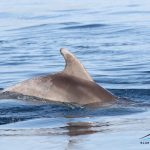July 26, 2018 — Croatia may be experiencing the return of a familiar friend, decades after being fished and slaughtered out of this chunk of the Adriatic Sea.
In 2015, scientists spotted about 30 of them. This July, they saw about 50 — with babies.
How does one say “Welcome back!” in dolphin-ese?
Scientists at the Blue World Institute of Marine Research and Conservation, based in Lošinj, have seen the short-beaked common dolphin with increasing regularity over the last few years. A recent sighting has them entraining a once-crazy notion: the once-abundant species may be returning to its former home in the Adriatic Sea.
The researchers spotted the dolphins (delphinus delphis) near Telaščica Nature Park and Kornati National Park this month, according to Morski.hr. The group spent about two hours with the dolphins, monitoring their behavior and snapping footage.
“We were particularly happy with the fact that in the group were young ones, as well as a newborn,” Tihana Vučur, a researcher at the Institute told Morski.
The common dolphin, along with the bottlenose dolphin, were the two most-abundant in the Adriatic and Mediterranean Seas. Many countries organized culling campaigns, believing the dolphins were a threat to the fishing industry, as well as “pests.”
Yugoslavia was among them, with the 1950s and 1960s seeing a push to effectively eradicate the species. A reward was paid for every dolphin caught.
It worked, and combined with fishing the common dolphin was effectively extinct within the Adriatic Sea by the early 1970s.
Sightings since then have been rare; evidence of breeding nonexistent. Which makes the appearance of the newborn so promising.
Common Dolphins, as their names suggest, can be found in moderate and tropical zones. They have dark backs and light bellies, with yellow-like flanks. They’re among the smaller of all dolphin varieties, reaching just over two meters, and can live up to 30 years.
The researchers use the unique scratches and scars on the dolphins’ back as a means to identify them individually. The Blue World Institute will check for migratory habits by comparing the photos and evidence they collected in Kornati to those catalogued by colleagues in Greece and Italy.
The scientists used the same method to confirm at least five of the dolphins they saw recently were in Kornati in 2016 as well.
The Blue World Institute keeps track of dolphins and whales sightings, and invites anyone to report one via email or their Facebook page.











